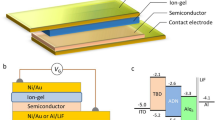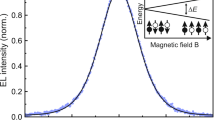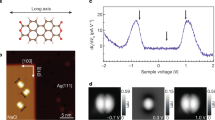Abstract.
We have used electrically detected magnetic resonance (EDMR) to study a series of multilayer organic devices based on aluminum (III) 8-hydroxyquinoline (Alq3). These devices were designed to identify the microscopic origin of different spin-dependent processes, i.e. hopping and exciton formation. The EDMR signal in organic light-emitting diodes (OLEDs) based on Alq3 is only observed when the device is electroluminescent and is assigned to spin-dependent exciton formation. It can be decomposed in at least two Gaussians: one with peak-to-peak line ( ΔHPP) of 1.6 mT and another with ΔHPP of 2.0 to 3.4 mT, depending on bias and temperature. The g-factors of the two components are barely distinguishable and close to 2.003. The broad line is attributed to the resonance in Alq3 anions, while the other line is attributed to cationic states. These attributions are supported by line shape and its electrical-field dependence of unipolar Alq3-based diodes, where hopping process related to dication and dianion formation is observed. In these unipolar devices, it is shown that the signal coming from spin-dependent hopping occurs close to organic semiconductor/metal interfaces. The sign of the magnetic-resonance-induced conductivity change is dominated by charge injection rather than charge mobility. Our results indicate that the probability of singlet exciton formation in our OLEDs is smaller than 25%.
Similar content being viewed by others
References
C.W. Tang, S.A. Vanslyke, Appl. Phys. Lett. 51, 913 (1987).
L.S. Hung, C.H. Chen, Mater. Sci. Eng. R 39, 143 (2002).
V.V.N.R. Kishore, N. Periasamy, B. Bhattacharjee, R. Das, P.L. Paulose, K.L. Narasimhan, Chem. Phys. Lett. 367, 657 (2003)
C.F.O. Graeff, in Encyclopedia of Nanoscience and Nanotechnology, edited by H.S. Nalwa, Vol. 2 (American Scientific Publishers, Stevenson Ranch, Cal., 2004) pp. 1-745.
F.A. Castro, G.B. Silva, L.F. Santos, R.M. Faria, F. Nuesch, L. Zuppiroli, C.F.O. Graeff, J. Non-Cryst. Solids 338-40, 622 (2004).
G. Li, C.H. Kim, P.A. Lane, J. Shinar, Phys. Rev. B 69, 165311 (2004).
E. Tutis, D. Berner, L. Zuppiroli, J. Appl. Phys. 93, 4594 (2003).
A. Salleo, R.A. Street, Phys. Rev. B 70, 235324 (2004).
N. Kirova, S. Brazovskii, Synth. Met. 76, 229 (1996)
M. Wohlgenannt, K. Tandon, S. Mazumdar, S. Ramasesha, Z.V. Vardeny, Nature 409, 494 (2001)
M. Stossel, J. Staudigel, F. Steuber, J. Blassing, J. Simmerer, A. Winnacker, Appl. Phys. Lett. 76, 115 (2000).
H. Dersch, L. Schweitzer, J. Stuke, Phys. Rev. B 28, 4678 (1983).
L.S. Swanson, J. Shinar, A.R. Brown, D.D.C. Bradley, R.H. Friend, P.L. Burn, A. Kraft, A.B. Holmes, Phys. Rev. B 46, 15072 (1992)
M. Segal, M.A. Baldo, R.J. Holmes, S.R. Forrest, Z.G. Soos, Phys. Rev. B 68, 075211 (2003)
J.S. Wilson, A.S. Dhoot, A.J.A.B. Seeley, M.S. Khan, A. Kohler, R.H. Friend, Nature 413, 828 (2001).
S.W. Yin, L.P. Chen, P.F. Xuan, K.Q. Chen, Z. Shuai, J. Phys. Chem. B 108, 9608 (2004).
S. Kuroda, K. Marumoto, Y. Shimoi, S. Abe, Thin Solid Films 393, 304 (2001).
A. Curioni, W. Andreoni, Ibm J. Res. Dev. 45, 101 (2001).
I.G. Hill, A. Kahn, J. Cornil, D.A. dos Santos, J.L. Bredas, Chem. Phys. Lett. 317, 444 (2000)
Z. Ding, A.F. Gulla, D.E. Budil, J. Chem. Phys. 115, 10685 (2001).
M. Plato, H.J. Steinhoff, C. Wegener, J.T. Torring, A. Savitsky, K. Mobius, Mol. Phys. 100, 3711 (2002).
W.B. Mims, The Linear Electric Field Effect in Paramagnetic Resonance (Clarendon Press, Oxford, 1976).
Author information
Authors and Affiliations
Corresponding author
Rights and permissions
About this article
Cite this article
Graeff, C.F.O., Silva, G.B., Nüesch, F. et al. Transport and recombination in organic light-emitting diodes studied by electrically detected magnetic resonance. Eur. Phys. J. E 18, 21–28 (2005). https://doi.org/10.1140/epje/i2005-10026-6
Received:
Accepted:
Published:
Issue Date:
DOI: https://doi.org/10.1140/epje/i2005-10026-6




